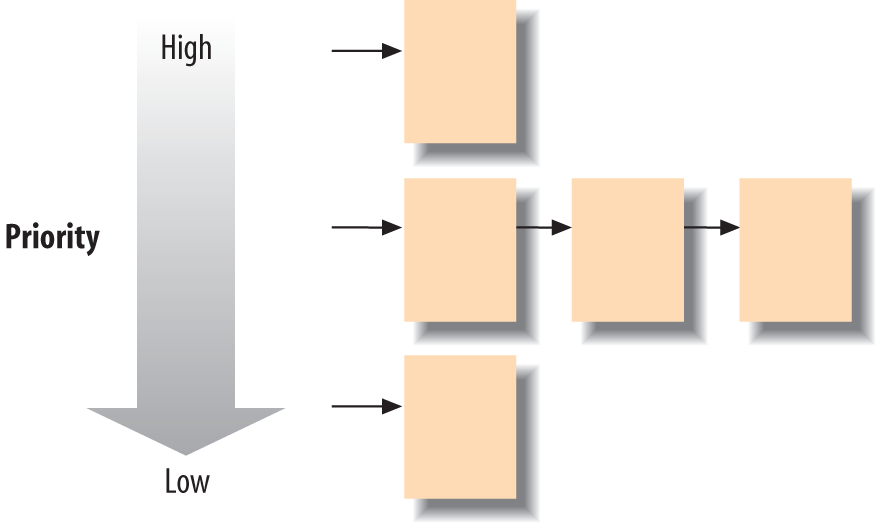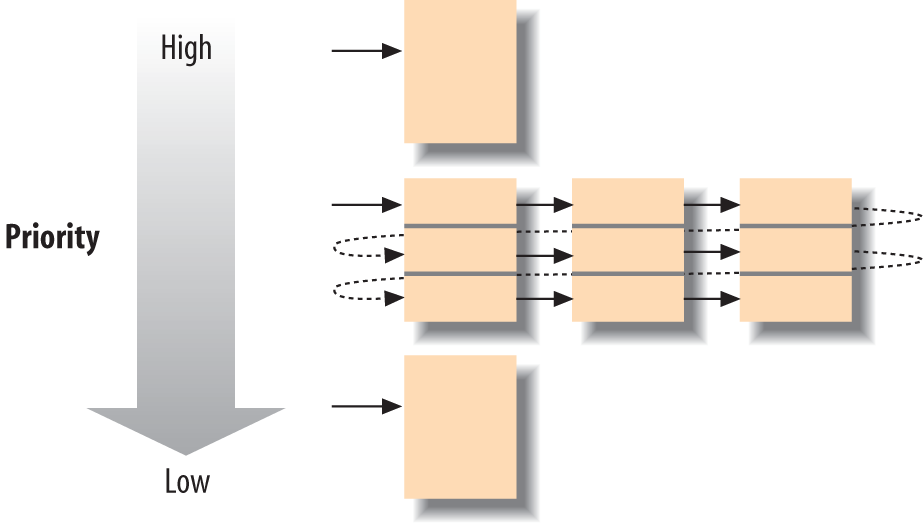Java makes few guarantees about how it schedules threads. Almost all of Java’s thread scheduling is left up to the Java implementation and, to some degree, the application. Although it might have made sense (and would certainly have made many developers happier) if Java’s developers had specified a scheduling algorithm, a single algorithm isn’t necessarily suitable for all the roles that Java can play. Instead, Java’s designers put the burden on you to write robust code that works no matter the scheduling algorithm, and let the implementation tune the algorithm for the best fit.[27]
The priority rules that we describe next are carefully worded in the Java language specification to be a general guideline for thread scheduling. You should be able to rely on this behavior overall (statistically), but it is not a good idea to write code that relies on very specific features of the scheduler to work properly. You should instead use the control and synchronization tools that we have described in this chapter to coordinate your threads.[28]
Every thread has a priority value. In general, any time a thread of a higher priority than the current thread becomes runnable (is started, stops sleeping, or is notified), it preempts the lower-priority thread and begins executing. By default, threads with the same priority are scheduled round-robin, which means once a thread starts to run, it continues until it does one of the following:
Sleeps, by calling
Thread.sleep()orwait()Waits for a lock, in order to run a
synchronizedmethodBlocks on I/O, for example, in a
read()oraccept()callExplicitly yields control, by calling
yield()Terminates, by completing its target method or with a
stop()call (deprecated)
This situation looks something like Figure 9-4.
At any given time, a thread is in one of five general
states that encompass its lifecycle and activities. These states are
defined in the Thread.State
enumeration and queried via the getState() method of
the Thread class:
NEWRUNNABLEThe normal active state of a running thread, including the time when a thread is blocked in an I/O operation, like a read or write or network connection.
BLOCKEDThe thread is blocked, waiting to enter a synchronized method or code block. This includes the time when a thread has been awakened by a
notify()and is attempting to reacquire its lock after await().WAITING, TIMED_WAITINGThe thread is waiting for another thread via a call to
wait()orjoin(). In the case ofTIMED_WAITING, the call has a timeout.TERMINATEDThe thread has completed due to a return, an exception, or being stopped.
We can show the state of all threads in Java (in the current thread group) with the following snippet of code:
Thread[]threads=newThread[64];// max threads to showintnum=Thread.enumerate(threads);for(inti=0;i<num;i++)System.out.println(threads[i]+":"+threads[i].getState());
You will probably not use this API in general programming, but it is interesting and useful for experimenting and learning about Java threads.
In addition to prioritization, all modern systems (with the exception of some embedded and “micro” Java environments) implement thread time-slicing. In a time-sliced system, thread processing is chopped up so that each thread runs for a short period of time before the context is switched to the next thread, as shown in Figure 9-5.
Higher-priority threads still preempt lower-priority threads in this scheme. The addition of time-slicing mixes up the processing among threads of the same priority; on a multiprocessor machine, threads may even be run simultaneously. This can introduce a difference in behavior for applications that don’t use threads and synchronization properly.
Strictly speaking, because Java doesn’t guarantee time-slicing, you shouldn’t write code that relies on this type of scheduling; any software you write should function under round-robin scheduling. If you’re wondering what your particular flavor of Java does, try the following experiment:
publicclassThready{publicstaticvoidmain(Stringargs[]){newShowThread("Foo").start();newShowThread("Bar").start();}staticclassShowThreadextendsThread{Stringmessage;ShowThread(Stringmessage){this.message=message;}publicvoidrun(){while(true)System.out.println(message);}}}
The Thready class starts up two
ShowThread objects. ShowThread is a thread that goes into a hard
loop (very bad form) and prints its message. Because we don’t specify a
priority for either thread, they both inherit the priority of their
creator, so they have the same priority. When you run this example, you
will see how your Java implementation does its scheduling. Under a
round-robin scheme, only “Foo” should be printed; “Bar” never appears.
In a time-slicing implementation, you should occasionally see the “Foo”
and “Bar” messages alternate (which is most likely what you will
see).
As we said before, the priorities of threads exist as a general guideline for how the implementation should allocate time among competing threads. Unfortunately, with the complexity of how Java threads are mapped to native thread implementations, you cannot rely upon the exact meaning of priorities. Instead, you should only consider them a hint to the VM.
Let’s play with the priority of our threads:
classThready{publicstaticvoidmain(Stringargs[]){Threadfoo=newShowThread("Foo");foo.setPriority(Thread.MIN_PRIORITY);Threadbar=newShowThread("Bar");bar.setPriority(Thread.MAX_PRIORITY);bar.start();}}
We would expect that with this change to our Thready class, the Bar thread would take over
completely. If you run this code on the Solaris implementation of Java
5.0, that’s what happens. The same is not true on Windows or with some
older versions of Java. Similarly, if you change the priorities to
values other than min and max, you may not see any difference at all.
The subtleties relating to priority and performance relate to how Java
threads and priorities are mapped to real threads in the OS. For this
reason, thread priorities should be reserved for system and framework
development.
Whenever a thread sleeps, waits, or blocks on I/O, it
gives up its time slot and another thread is scheduled. As long as you
don’t write methods that use hard loops, all threads should get their
due. However, a thread can also signal that it is willing to give up its
time voluntarily at any point with the yield() call. We can
change our previous example to include a yield() on each iteration:
...staticclassShowThreadextendsThread{...publicvoidrun(){while(true){System.out.println(message);yield();}}}
You should see “Foo” and “Bar” messages strictly alternating. If you have threads that perform very intensive calculations or otherwise eat a lot of CPU time, you might want to find an appropriate place for them to yield control occasionally. Alternatively, you might want to drop the priority of your compute-intensive thread so that more important processing can proceed around it.
Unfortunately, the Java language specification is very weak with
respect to yield(). It is another one
of those things that you should consider an optimization hint rather
than a guarantee. In the worst case, the runtime system may simply
ignore calls to yield().
[27] A notable alternative to this is the real-time Java specification that defines specialized thread behavior for certain types of applications. It was developed under the Java community process and can be found at https://rtsj.dev.java.net/.
[28] Java Threads by Scott Oaks and Henry Wong (O’Reilly) includes a detailed discussion of synchronization, scheduling, and other thread-related issues.
Get Learning Java, 4th Edition now with the O’Reilly learning platform.
O’Reilly members experience books, live events, courses curated by job role, and more from O’Reilly and nearly 200 top publishers.



